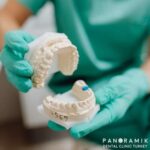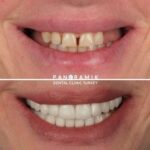
The Pinhole Gum Technique
December 8, 2023
Full Mouth Treatments
December 8, 2023When a dentist performs sophisticated procedures like dental implants, they’ll frequently want to know what’s beneath the surface of your gums and teeth, which is where a CT scan comes in handy.
The CBCT (Cone Beam Computerized Tomography) scanner is a specifically constructed equipment that employs x-rays in a cone beam, primarily used for medical imaging.
A CT scan generates a sequence of high-quality x-ray pictures, which are then stitched together using modern computer technology to create a series of slices. A CBCT scanner, such as those used in dentistry, emits less radiation than larger-scale CT scans like those seen in your hospital outpatient department.
On a CT scan, what can be seen?
The position of the bone structures around your face, nasal cavity, and sinuses may be properly plotted by the dentist. This enables them to assess any current illness as well as arrange surgical therapies. Because a dental Cone Beam scanner lacks the same level of resolution as an outpatient CT scan, it cannot be utilized to assess soft tissue structures such as muscles, lymph nodes, nerves, or glands.
Why is a CBCT scan required by a dentist?
As the cost of a cone beam scanner decreases, more dental offices are purchasing this advanced piece of equipment, which they utilize largely for the following purposes:
-Prior to surgery, carefully arrange the placement of the dental implant.
-Bone amount is assessed prior to dental implant implantation, particularly in relation to sinus position and the possibility of grafting/sinus lift procedures.
-Prior to the implantation of dental implants, important nerve canals are evaluated and located.
-Surgical extraction of impacted wisdom teeth are being planned.
-Jaw tumour detection and surveillance.
-finding and diagnosing persistent pain’s pathological roots
How to get ready for a dental x-ray
You’ll be relieved to learn that a dental CT scan requires relatively little preparation.
During the scan, your dentist will require a good view of your head, face, and neck; any object that might interfere with the image should be removed.
3DC Tomography 3-Earrings.
-Tongue piercings
-Piercings on the nose.
-Piercings on the face.
-Necklaces.
-Pins or hair grips
-Dental appliances that can be removed.
What can you expect from a CBCT scan?
Unlike outpatient CT scans at a hospital, which require you to lie down, a dental scan is typically performed while you are standing.
Simply stand in a designated location in front of the scanner, grasp the bars in front of you, and guides will be installed to keep your head still.
The scanner then spins around your head, capturing a sequence of pictures that are subsequently rearranged into a 3D x-ray by the software.
The entire procedure just takes a few minutes and is entirely painless.
